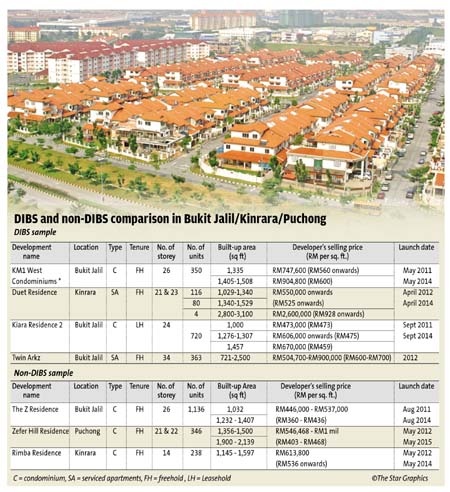Does DIBS benefit buyers?
 I recently went to a SOHO launch where the developer offered a 10% rebate and DIBS (developers’ interest-bearing scheme) package. With regards to the rebate, 10% of the selling price will be waived provided the sale and purchase agreement (SPA) is signed within a certain period.
I recently went to a SOHO launch where the developer offered a 10% rebate and DIBS (developers’ interest-bearing scheme) package. With regards to the rebate, 10% of the selling price will be waived provided the sale and purchase agreement (SPA) is signed within a certain period.
I understand that the rebate is not included in the SPA and is only given upon vacant possession. This looks unfair, what happens if there is no “vacant possession” where the developer does not complete the construction?
The developer would have collected progress claims and there is no guarantee there is vacant possession since it would have to await completion and since the DIBS and rebate were the attractions to such a launch, it would be a fair deal only if the buyer gets the discount upfront, right?
The above is a letter to StarProperty portal.
That 10% rebate is just an inducement to buy. Either way, whether the buyer gets the discount upfront, or upon vacant possession, this may not be a fair deal to the buyer. Here is the long explanation.
Close to five years now, a majority of developers have been offering DIBS for different types of projects landed, condominiums and serviced apartments irrespective of pricing.
While these financing schemes may seem an easy route to own a property, buyers who opt for a DIBS package may really need to consider if they want to take this route in order to own a property.
The issue of DIBS is brought up once again because according to a developer who declined to be quoted, DIBS packages are not in favour of the buyer.
“DIBS packages effectively push up the selling price by between 5% and 15%,” he says.
A property consultant who declined to be named says there is a difference of as high as between 20% and 25% for a DIBS and a non-DIBS package.
“On a per sq ft basis, the current market value for a property may be RM300 per sq ft. Because the developer is offering a DIBS package, somebody has to fork out the interest. So instead of selling the house at market value of RM300, he ups it by 20% and sells it at RM360 per sq ft.
“The buyer is, therefore, paying future prices today. The prevalent attitude today is, in the event prices do not reach RM360 per sq ft, he will forgo the commitment. But he is still committed to the loan. If he does not pay, the bank will take action to auction off the property. But let’s assume he decides to keep the property, the DIBS package is still not in his favour because if the price does not reach RM360 per sq ft – that being the price he paid on a per sq foot under DIBS – the buyer will have to top up the balance,” the consultant says.
Generally, there are two common misconceptions among buyers. The first is that this is a built-then-sell (BTS) scheme. This is not a BTS scheme.
“In a BTS scheme, the buyer pays 10% to 15% initially but he has not locked himself into a loan agreement. Although he has paid a commitment fee, that commitment hinges on the completion of the house, according to what the developer has promised him. He effectively can walk away from the purchase,” the consultant says.
In a DIBS package, the buyer is locked into a loan agreement, the consultant says.
“The common public perception is Don’t worry, nothing to be paid. only 5%, or 10%’. The reality is that, they cannot walk away because they have committed themselves to service the loan. The only way to walk away from it is to flip it.”
The consultant says if the project is abandoned, the buyer is still committed to the mortgage.
Besides buyers paying future prices, the consultant says DIBS packages encourage speculation, that is, to buy with the intention to flip. It was this that prompted the Singapore government to ban interest bearing schemes even as far back as in 2009, followed subsequently by other measures to curb speculation.
“They are gambling that prices will go up. If a buyer has already paid future prices of between 20% to 25% , what is there to make, unless they expect to charge the next buyer another 25% to 30%? It is this sort of attitude, when enough people do it – the massess so to speak – that push up property prices,” he says, adding that the buyer can only flip when he has a margin of more 15% to make (as profit).
He says the authorities should enforce developers to put in big fine print what DIBS packages involve.
“If we overdo the DIBS, there is a snowball effect. Over time, it distorts prices,” he says.
As per the last budget, effective Jan 1 this year, the government raised the RPGT from the previous 10% to 15% on all properties sold during the first two years from date of purchase, and 10% (previously 5%) for those sold between the third and fifth year. There is no tax on properties disposed after the fifth year.
Because the effective date begins on the signing of the sales and purchase agreement date, and it generally takes two to three years to build a landed and a condominium property respectively, the buyer will be taxed 10% of his gains on the third or fourth year (the first two years being the construction stage). There are mixed views how effective the real properties gains tax (RPGT) may be to deter speculation. A total of RM1.09 billion RPGT revenue was collected in 2011 and RM 1.248 billion in 2012.
The other alternative is to ban DIBS for housing that is below a certain value, for example RM1mil, he says.
The second option is to opt for the normal progressive payments. There is a third option, and that is to buy a completed project. But many buyers do not want to do that because the seller would have made a profit.
Moreover, not many developers are offering this built-then-sell (BTS) route, which continues to be promoted by the National House Buyers’ Association (HBA) today.
In a previous column for StarBizWeek, HBA honorary secretary-general Chang Kim Loong writes: “… the buyers truly do not make any payment except for the deposit of 10% until vacant possession because the end-financing loans do not kick in until the houses are completed with all the certifications obtained and keys with vacant possession are available.”
Elvin Fernandez, the managing director of Khong & Jaafar group of companies says while the debate for austerity versus monetary expansion policies continues, the fact remains that there is a flood of money rushing throughout the global economy in search of higher yields. This pushes up prices of bonds and shares to unrealistic levels. Much of these money have gone into alternative investments like properties.
“We are concerned about this flood of money, particularly in this region which may not have suffienct regulatory infrastructure to absorb this money, or to deal with it,” Elvin says.
He says governments in the region, for example Hong Kong and Singapore, whose economies are more open to this flood of money have instituted a range of regulatory measures, known as macro-prudential measures to try and stem the ill effects that this flood of money can cause in property markets.
How does this affect the Malaysian property market or Malaysian housing market?
He says in order to prevent the property market from stalling, developers in early 2009 rushed in with a lot of 5/95 schemes and other incentives in order to maintain interest in the market. These incentives include DIBS, absorption of stamp duty and legal fees, rental guarantees, cash-back payments and early bird discounts. These incentives essentially bring prices down.
“But what is important is, if the discounts through incentives are not quantified and made known to all market participants, then the headline price – the price with the incentives – will be taken as the real market price, which it is not. The real market price would be the price after quantifying and deducting the incentives. This real price can then be also compared with prices in the secondary market.”
Elvin says this is important because “banks give loans on the market value and, in many cases, loans for purchases from the primary market”.
“Banks do not need professional valuations from independent valuers when buyers buy directly from the developers. Consequently, the lending is based on the headline price. In the event of a default and foreclosure, the bank will not be able to recover the full loan as it was based on a headline price with the incentives. And at the point of foreclosure, the price anyone will bid is certainly not a price with the previous incentives. In the event of a market downturn, and bearing in mind now that the percentage of primary sales have dramatically increased in the past few years, questions of financial stability may arise,” he says.
Secondly, Elvin says the National Property Information Centre (Napic) has been building up over the years a robust property index including a house price index. It is important for this price indices to reflect the real prices.
While it is fair for developers to give discounts by way of incentives, developers should state clearly in their documents and brochures the price or value of the incentives given. The real price should be transparently known to the buying public, he says.
This measure of transparency has been introduced in Singapore, he says.
Because of the incentives, the primary housing market, where buyers buy directly from developers, which used to hover around 12% of the total market has now shot up to 21% in 2011, and 22% in 2012. Consequently, the secondary market has receded.
“In other words, people now buy from the primary market because of the incentives. And this could also signal that the market, as a whole, which is usually and still is heavily biased towards the secondary market, is showing signs of slowing down.
Elvin says according to Napic, total residential transactions in the secondary market has come down from 214,044 in 2011 to 212,428 in 2012.
Source: StarProperty.my

